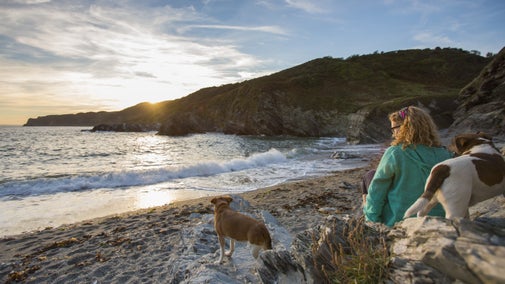
Discover more at Studland Bay
Find out how to get to Studland Bay, where to park, the things to see and do and more.

With four miles of beautiful beaches lining the sheltered waters of Studland Bay, the area is ideal for family days out, beach games, sandcastles and watersports. Explore the Dorset coast with sandy walks along the water’s edge or head inland through the dunes on the waymarked paths. However you choose to spend your day, Studland Bay provides an invigorating visit.
The beaches of the Studland peninsula stretch from the boundary of the Jurassic Coast World Heritage Site at Old Harry Rocks north to Shell Bay, where a chain ferry provides a link to Poole and Bournemouth.
Shell Bay is at the mouth of Poole Harbour with stunning views across the water to Sandbanks, Bournemouth, Hengistbury Head and the Isle of Wight. The wide sandy beach is popular with families and is great for walkers and beachcombers to explore.
Facilities at Shell Bay: This beach is the furthest from the main facilities at Knoll Beach. There is a National Trust car park with toilets. Shell Bay can be accessed from the boardwalk at Shell Bay car park, or pedestrians can step directly onto the beach from the chain link ferry which operates between Studland and Sandbanks in Poole for pedestrians, cyclists and vehicles. Here you’ll find the marker for the South West Coastal Path, England’s longest waymarked path.
This beach is backed by a wilderness of dunes, has open spaces, shallow waters and designated swimming-only zone in the summer. There is also a 1km designated naturist area at Knoll Beach.
Facilities at Knoll Beach: This beach is easily accessed from the large car park. Facilities here include the National Trust shop, Knoll Beach café, the Knoll Beach Office plus toilets, an outdoor shower and taps to help wash off sand. The friendly Visitor Welcome Team can assist with everything from beach hut bookings to borrowing beach wheelchairs. Reservations are taken in advance and are subject to availability by contacting: Call the team to make your reservation. / Send an email to make your reservation.
Pedalo boats and paddleboard hire: Pedalo boats and stand-up paddleboards can be hired on the beach from Studland Water Sports (non National Trust).
You can also explore what else Studland has to offer on the Sand Dunes Trail and Woodland Walk or discover the wildlife that lives here from the Rees Cox bird hide overlooking Little Sea.

South Beach is the smallest beach and popular with locals and visitors alike, with paddleboarders and kayakers taking advantage of the sheltered waters in the bay. On the beach, you’ll find Joe’s Café (non National Trust), a designated swimming-only zone in the summer and some good spots for rock-pooling at low tide.
South Beach car park, with nearby toilets (operated by Purbeck District Council) is a short walk through the village to access the beach.
We're working towards a sustainable future for Middle Beach and its facilities, which are both impacted by coastal change. The coast is an everchanging environment, constantly being reshaped by the waves, winds and tides. Climate change is likely to increase the rate of coastal change that we experience at Studland. That is why it is important that we act now to understand how the coastline might change, and how we can best adapt to this change. You can find out more about the Middle Beach project on our 'Adapting to Coastal Change at Middle Beach web page'.
Look for the beach safety signage in case of emergencies.
No matter which beach you choose, you’ll be met with sea views stretching from Old Harry Rocks across to the Isle of Wight.
Well-behaved dogs are welcome all year round but restrictions apply during the summer months - visit our 'Visiting Studland Bay with your Dog' web page to find out more.

The wilderness of Studland and Godlingston Heath is the largest expanse of unspoiled lowland heath to survive in Dorset. It’s also perhaps the closest thing to the landscape described by Thomas Hardy that can be found in the 21st century.
The Purbecks’ heaths offer uninterrupted vistas of gently undulating hills covered in purple heather as immortalised in Hardy's stories, such as the Return of the Native. Some of the best views are from the dramatic Agglestone rock,
From this 400-tonne rock that sits alone on a hill, views sweep down to the shores of Poole Harbour. Legend has it that it was placed there by the Devil, who was sitting on the nearby Needles when he saw Corfe Castle being built in the distance.
He was so offended by its beauty that he threw his cap at it. However, the missile fell short and became the Agglestone rock. Another less legendary theory is that the five-metre rock is part of a band of ironstone that crosses the heath.
Studland’s dunes are unusual for several reasons. Sand only began to be deposited on the Studland peninsula about 500 years ago and in that time the Little Sea was formed. This is a freshwater lake, found in the wetlands just in-land from Studland beach.
Also, the dunes at Studland are made of acidic sand with very low shell content. This acidity means that after about 60 years, when the roots of the marram grass have anchored the sand in place, they become colonised by heather.
Most of the Studland dune system is characterised by an unusual habitat known as dune heath. With more than 75 hectares, Studland is the largest area of dune heath on the south coast.
The heath around Studland is more than a beautiful open space to walk through. Lucky visitors will spot birds, including the internationally protected nightjar and Dartford warbler. This is also the only landscape where you’ll find all six of Britain’s native reptiles.
The shrub acts as important shelter for smaller animals, including the smooth snake, which is one of the rarest reptiles. Plus, look out for sand lizards sunning themselves on the bare ground.
Across most of the heaths, common heather (or ling) is the dominant plant. However, most of Studland’s dunes are home to an unusual habitat known as dune heath. With more than 75 hectares, it’s the largest area of dune heath on England’s south coast.
These younger dunes welcome wildflowers as well as rare plants, such as prickly saltwort and sea stock, which is a threatened species as listed in the Red Data Book.
If you’re interested in plants, head to the wettest bits of the Purbeck’s heaths, in the valley bottoms. This is where you’ll find the much less common heather, called Dorset heath. In the wettest areas of all, mires are dominated by bog mosses and carnivorous plants.
Studland’s dune heath is home to important lichen and fungi. Nowhere on the south coast can you see so many examples of the Cladonia ‘reindeer’ lichen as here at Studland. It’s also the only site in England and Wales for the sand earthtongue fungus.
Studland Bay is home to creatures of all sizes and areas of dense, mature shrubs are important for some specialist insects, such as the emperor moth. The heath also welcomes two of the rarest insects, the heath tiger beetle and the Purbeck mason wasp.

Find out how to get to Studland Bay, where to park, the things to see and do and more.
Discover where to walk with your four-legged friend at Studland Bay and how to ensure everyone enjoys the beach, whether on two feet or four paws.

Discover what’s on the menu at Knoll Beach Café, where you can sit and sip while enjoying sea views, then pop into the shop for a treat to take home.

Discover all you need to know about the 900m area of Knoll Beach designed for naturism, probably the best-known beach of its kind in Britain, and marked with signs and posts.

Learn how this four-mile stretch of coastline was used for military operations during the Second World War, and how it came to be donated to the National Trust in 1981.

Discover the 890 miles of beautiful coastline in our care. Plan your next coastal adventure, whether you want to explore soft, sandy beaches or rugged, windswept cliffs.

Explore the miles of natural beautiful coastline and beaches in Dorset, from the rugged Jurassic Coast to the golden sandy beaches of Studland Bay.

Try out the ‘50 things to do before you’re 11¾’ activities children can enjoy by the sea, from paddling or swimming, to catching crabs and skimming stones.
